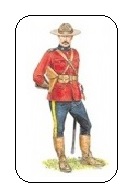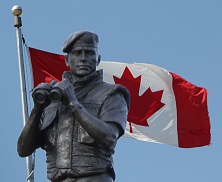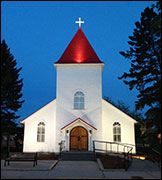True and Fascinating Canadian History
The Mystery of the Member
Who Never Knew His Real Rank
by J. J. Healy

I'm Irish. I use my roots as a lame excuse for occasionally getting riled. A poor approach shot won't do it, but maybe the long, dark, overcast, blah days of an Ottawa winter will set me off course. Let's be clear -- no one can list valid reasons for a long, cold and damp Canadian winter.
Anyway, if I'm home alone, I might fume for the day. And, if my wife is nearby, she forever tells me to: 'Let God worry about it'! So, who am I to quibble with God? Or, my wife? What kind of a man, even diagnozed with delirium, would take up that spousal challenge?
In the RCMP, things are different -- some members get easily riled every day over a lost promotion. Those who are overlooked may lament: 'the whole system has run amuk'! And, add this twist; Senior Officers say: 'It's competitive'. Other Officers say:'...you must return to the field for more operational experience.'
It's an historical fact that the first so called 'foot beat police' began in Québec City in the year 1651. From that time, policing and community life in Canada grew increasingly more complex. There came a time, in academia, when sociologists of all sorts began to look at society and pay attention to research that gauged the interaction between and among groups within the community.
Not too many years ago, criminologists also put policing under their watch. A rigorous, systematic approach took root. Ask, study, interview, observe, note, reflect, debate, and lecture. In depth distillation of policing became entries in publications. A mountain size surprise awaited academics. The police were surprised too. Executives began to better grasp the complexities of policing as a profession, the workings of the organization, their personnel and their community. Oh, one more analysis: the cost of policing.
It was discovered that, since the days of foot patrol in Québec City, policing indeed was a very unique profession -- set apart, distinct, different, from all the other honourable occupations in society. Different let's say, from denistry, medicine, teaching, carpentry, law, barbering, social work, politicians, professorship, motoring industry, business, juidiciary, pharmacy or owing and operating a shop.
Why is policing different; Is it the salary? The uniform? the cruiser? The community as a work site? Perhaps women in policing? Perhaps the entrance requirements? How about minorities in policing?
No, none of these.
The police are different from all other occupations because of the authority which has been handed to them, but most importantly, because of the raw, legitimate power which they have at their disposal. Legimate power sets the police apart in democracy or otherwise. And, an understanding about the nature and role of police and power in society can better serve both; the police and the community -- to de-escalate conflict, if possible, so as to save lives, injuries and damage.
So, in spite of rational reasoning and having an understanding about the role of the police, there continues to exist a high degree of mystery in the RCMP about the: means, methods, preferred experiences, skills and education which are preferred for some positions in the Force.
Our Vet of the Month was a very unique person. And qualified. He was a career member who specialized in northern duties. Years ago, dedication and hard work are two factors which motivated him. He served in war, in all parts of Canada, and at times endured in the worst of human conditions in the north including: lack of food, skimpy supplies, hard physical labour, cold weather and heavy rains. He wore his RCMP uniform as a visible, obvious representation of his occupation -- general community policing.
Trouble calls out to the uniformed police officer. It's the reason for the draw to general policing -- a job requirement which Commissioner Paulson completely understands.
The story ends in disappointment -- a setback no fault of this particular Officer.
I am extremely pleased that Friend of the Force, Mr. Dick Pulsifer reminded me of this story. I think he tells it best himself.
Thanks Dick very, very much for this story contribution!
Reporting from the Fort,
J. J. Healy
Dedicated to the Memory
of
Inspector Murray H. E. Hayne
Mr. Dick Pulsifer of Nova Scotia
Hi Joe:
I check your Blog daily and I always have a particular interest in your stories of the NWMP.
In the past, you have included stories on Reg. #869 (Officer 0.145) Inspector Murray H. E. Hayne. He was in the early NWMP and he held the rank of Staff Sergeant.
Staff Sergeant Hayne was posted to the Yukon in 1895, as part of the twenty members sent to the Yukon to open the first northerly post (Fort Constantine) at Fort Cudahy. The Fort was actually situated so the members could overlook the town of Forty Mile.
You also reported that after S/Sgt. Hayne completed his 2 years of police service in the Yukon, he authoured a book "The Pioneers of the Klondyke : Being an Account of Two Years Police Service on the Yukon". His book was first printed in England in 1897.
A couple of years ago, I was researching Reg.#2323 Everett John Ward NWMP, for your database. Cst. Ward (from Kentville, NS) was also included among the first twenty members who went to the Yukon. I searched for the book, authoured by S/Sgt. Hayne because I was hoping that Hayne might make reference to all the names of the members who served at that first Northerly Post.
Well, I did finally locate a source for a couple original copies of Hayne's book that were offered at over $400 each. But, I found reference of reprinted copies that were available in Africa. Eventually, I discovered that new copies are available from Amazon, in Ontario. I purchased a copy about 1 year ago, for $23.30 + s/h. As the original was published in 1897, the book is now in the public domain. An American publisher, with the belief that "old books deserve a new life", recently published these copies --- a new cover is on the book and the size of the font has been increased.
Anyway, I highly recommend the Hayne book for readers who want first hand and complete details of what those twenty original members experienced enroute to the north. When they departed from Seattle, it was more that a boat trip North --- members often went ashore to cut firewood to fuel the ship's boilers. After reaching their destination, there is an account of them renting a sawmill to saw logs, then a rail bed was built to move logs to the river, for rafting logs to the construction site. There are details of them renting abandoned miner's cabins to live in while their Fort was being constructed.
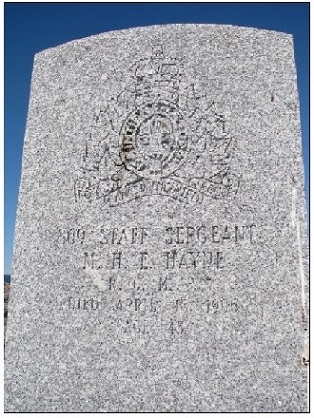
The members were racing against the coming cold weather and, in 6 weeks, they managed to construct eight seperate buildings and a stockade. The entire work project was done by members with no outside help. Where did they get windows and doors? --- they were shipped on the same boat that carried the members north. Then there was the problem of winter firewood and they rafted logs from at least 50 miles distant as there was no suitable wood near the Fort.
In winter, they were burning at least 2 cords of wood a day. S/Sgt. Hayne details their problems; dwindling supplies, limited food for their dogs, and having to release a prisoner as they could not feed him. Imagine their life -- time, dedication and hard work. S/Sgt. Hayne also includes stories of them requiring coverings of tarp over their beds, as rain water leaked through the sod roof of their buildings!
You may recall that S/Sgt. Hayne was also a qualified photographer. His photos in the book are his actual prints --- the quality is not too good but one has to realize there were photo developing problems caused by the extreme weather elements of the North.
Prior to completeing his two years service in the North, S/Sgt. Hayne requested a short leave from the Force --- actually, he went looking for gold and he did stake his own claim. When the members completed their 2 years of service, S/Sgt. Hayne had discovered gold and he left the Yukon with four other members. The remaining members (fifteen or so) stayed in the Yukon and they too searched for gold.
For those that enjoy reading of the early stories of the NWMP, recall this book was authoured by a real member who was there in the flesh. History of the Force doesn't get any better!
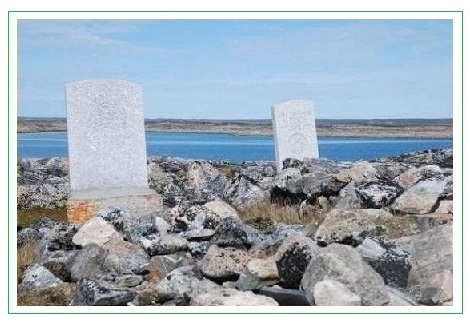
Now the Hayne Mystery. First, it's sad, indeed, that S/Sgt. Hayne died at the age of 45 years. He had completed service in the Boer War and he again returned to the Force for the Northerly service. Sadly, (here's the punch) S/Sgt. Haynee was never told or aware that he had been promoted to the rank of Inspector. The reason for not being told? Inspector Hayne was serving in Cape Fullerton at the time and communication from Ottawa was slow in the North.
I believe the news of Inspector Hayne's promotion was learned by others about 106 days after his death!
As a comfort to those sad and unusual circumstances in the life of Inspector Hayne, it is impressive that a new headstone was eventually erected by Force member which now shows his proper rank. It's now Inspector Murray H. E. Hayne.

Well Joe, this story is a chip of the Force's history from them 'ole days in the North.
Regards,
Dick Pulsifer, Friend of the Force
Nova Scotia
NS Vets)
CLICK HERE:
READ: THE SHORT LIFE OF STAFF SERGEANT M. H. E. HAYNE
I also want to acknowledge my appreciation to C/Supt. Brian Brennan of 'H' Div., for the photos which he sent to me for this story.
Brian, thanks again for your ongoing support for www.rcmpgraves and your enjoyment of Force history.
J. J. Healy
